Brand awareness is one of the “fuzziest” growth channels. And when things get fuzzy, you need concrete ways to prove your time and investment is paying off.
Below I’ve laid out 11 workflows you can follow to measure the success of your brand awareness—including some little-known Ahrefs use cases.
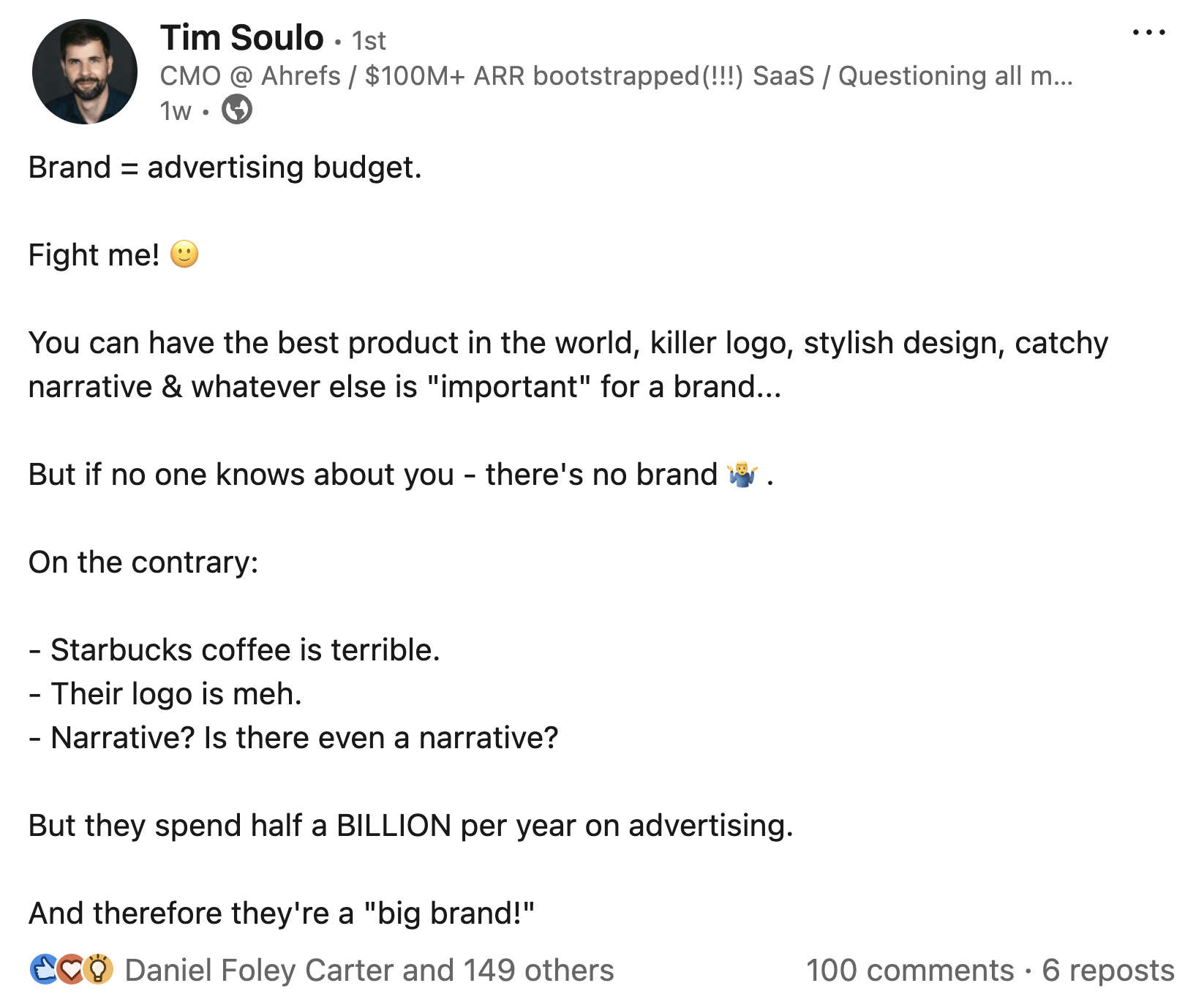
There’s no right way to manufacture awareness. Brands use different formats, channels, and varying levels of creativity to capture audience attention.
Examples of different types of brand awareness include:
- Sponsored content: Content that a brand pays to be featured alongside (e.g. their logo, product, or marketing message) to get in front of their target audience.
- Podcast adverts: Audio ad space that brands can buy to get in front of their target audience. Ads play before, during, or after the podcasts that their audience listen to.
- Billboard/out-of-home (OOH) advertising: Physical, offline ad space that brands can buy in the form of billboards, digital screens, or posters on transportation (e.g. busses).
- PR stunts/Guerilla marketing: Marketing that uses shock value or attention-grabbing ideas to create buzz and media coverage—typically executed in a creative, scrappy way.
- Branded content: Mass-appeal entertainment content that’s either sponsored, commissioned, or created by a company to match its audience’s values.
- Product placement: The subliminal advertising of a branded product in a piece of entertainment content, made to look natural within the storyline (e.g. in film, TV, or video games).
B2B companies spent 28.9% of their marketing budgets on brand awareness in 2024, according to Gartner—investing more than at any other stage of the customer journey.
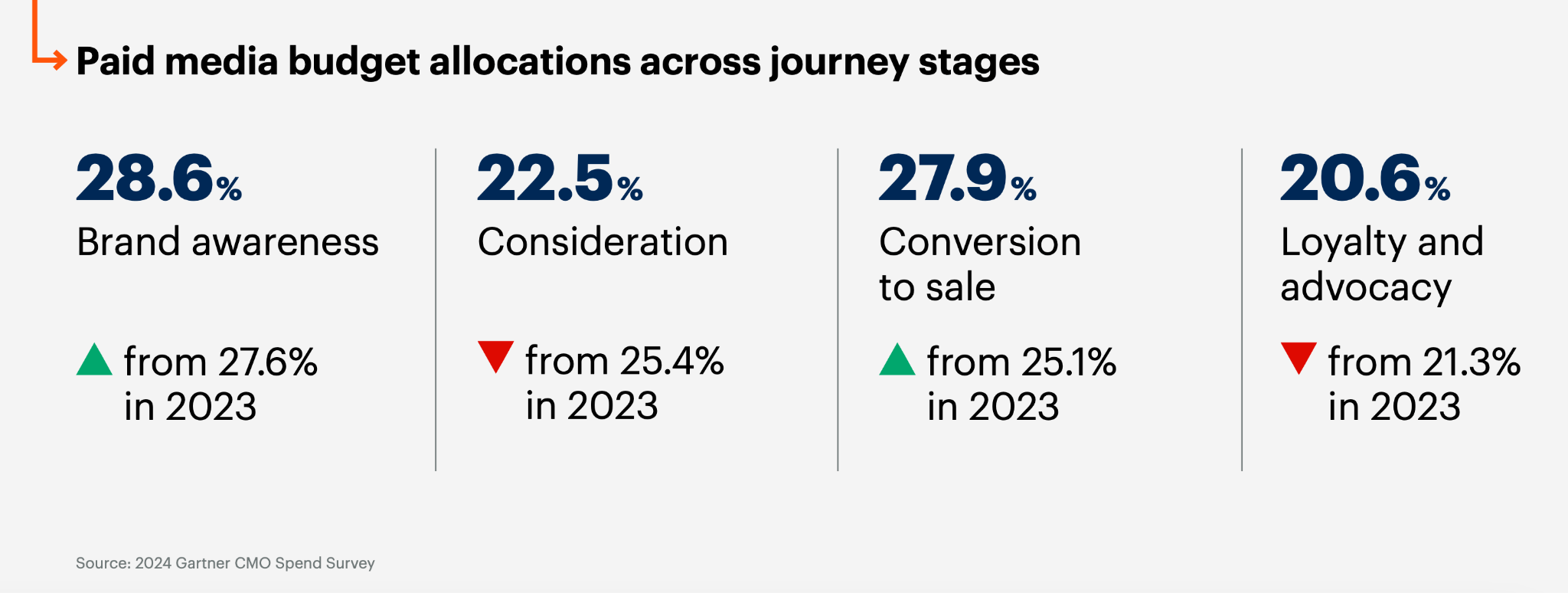
Companies can burn through cash on brand awareness campaigns, hoping people will recognize and love their brand. But generating a buzz with no sales is a situation no marketer wants to find themselves in.
“The key to building a successful brand with ads is that those ads need to actually convert people into buyers—otherwise you’ll waste a ton of money and could bankrupt your company if everyone knows your brand but doesn’t buy it.”
That’s why it’s crucial to measure the impact of your brand awareness strategy as you build it.
But I also, counterintuitively, think it’s the best time to build and measure your brand.
The more brand awareness, trust, and loyalty you build now, the less troubled you’ll be by these challenges in future. That’s because the benefits of brand awareness compound. Building awareness will bring you more:
- AI traffic. AI is an entirely new channel, giving you first mover advantage. The more your brand name crops up in topically relevant conversations online, the more likely it is to be mentioned and cited by LLMs and AI.
- Organic traffic. According to Mark Williams-Cook, Google assigns sites a “site quality” score, based on brand metrics. To understand your website’s quality, it analyzes your branded keywords, brand mentions that attract clicks (e.g. brand rich anchor text), and site clicks. Proactively building your brand awareness will inflate these metrics, boosting your site quality score and search ranking. Any ranking improvements will reinforce your brand visibility, creating a feedback loop of compounding awareness.
- Brand protection. Brand awareness means less dependence on any one channel, and diversified traffic from multiple sources and channels.
- Brand loyalty. Once your audience is aware of your brand, you can nurture that interest throughout the customer journey, turning it into positive brand sentiment and loyalty.
- Customers. Despite being tricky to attribute, when awareness booms, sales and conversions are often pulled along in the slipstream.
Just list out your branded or campaign-specific keywords, and see whether your brand awareness is falling, growing, or going steady.
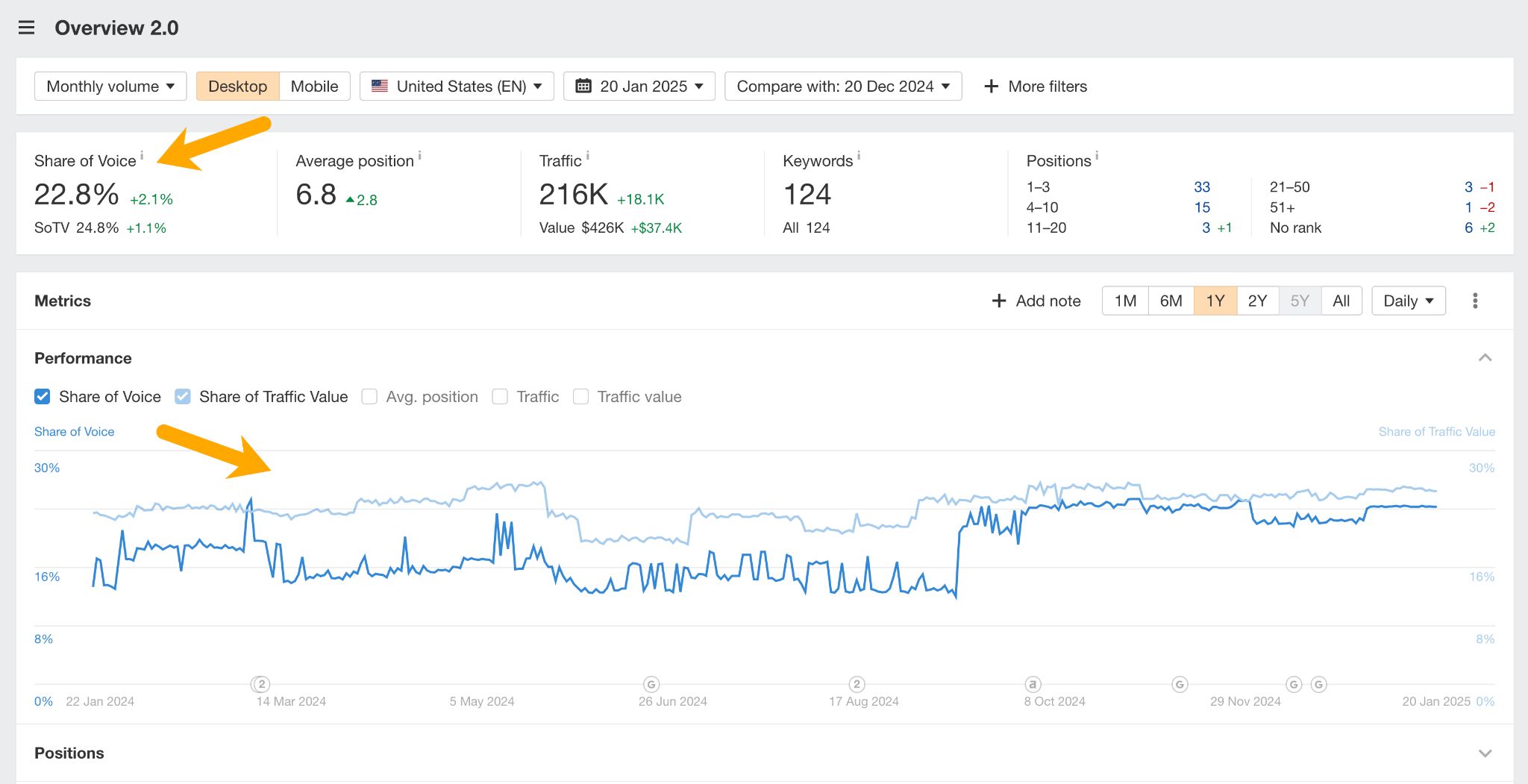
You can also benchmark your brand awareness against competitors in Rank Tracker, if you’ve specified them in your project setup.
To see that data, head to the “Competitors > Overview 2.0” tab on the left for Share of Voice and Share of Traffic Value timelines.
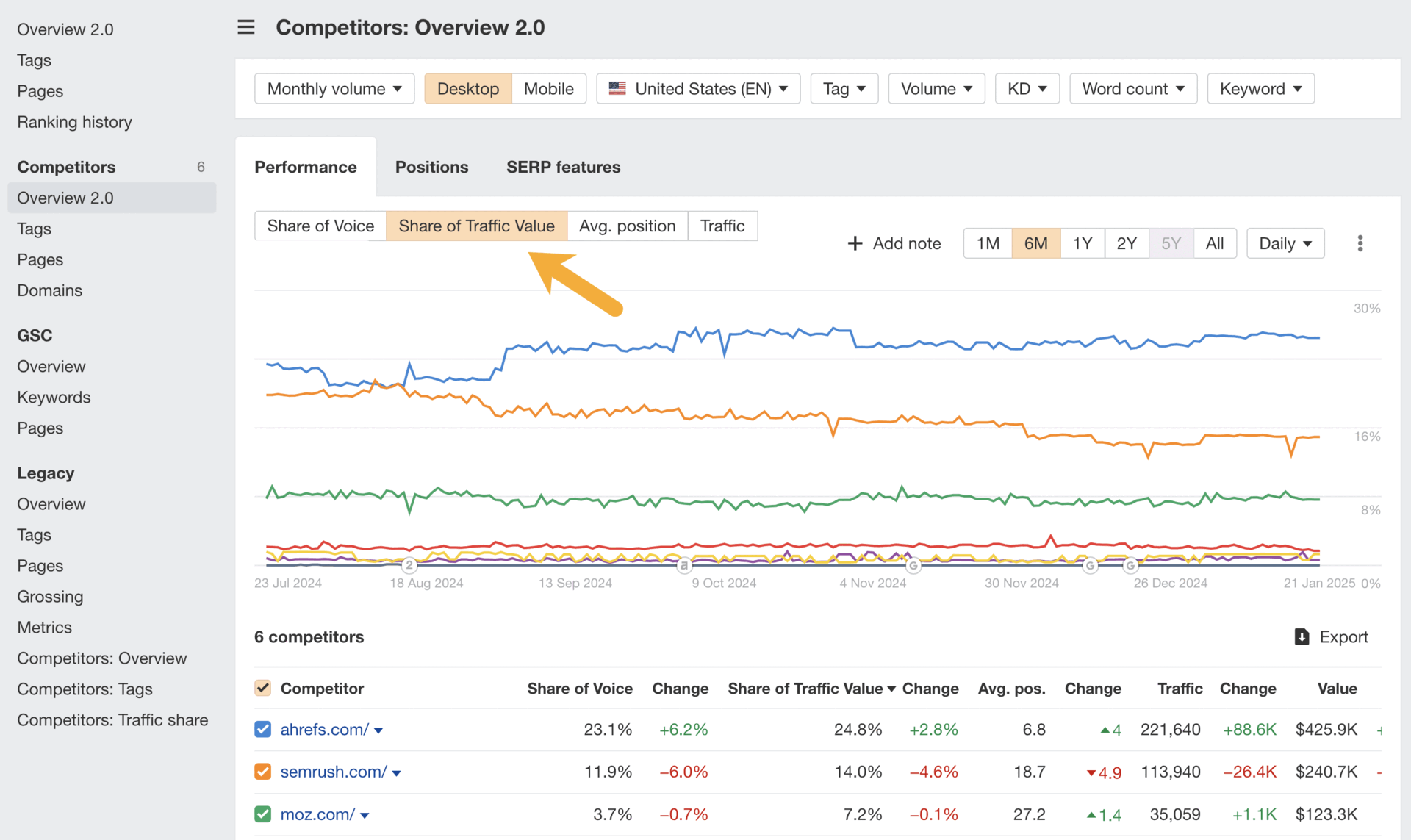
In this example, we’ve seen a 6.2% increase in our search share of voice over the last six months, bringing us up to an overall share of 23.1% for the keywords we care about.
These are the kinds of metrics to look back on when you’re proactively building your awareness.
Rank Tracker is great if you want to see your SoV trending over time, but for a snapshot view, head to Keywords Explorer.
Same as Rank Tracker, this report lets you track 10K keywords, so you can benchmark your brand’s top-level search presence against your closest competitors.
Here’s an easy workflow you can follow:
- Head to the Organic Keywords report and select the 10,000 highest ranking keywords for your domain
- Hit “Copy”
- Head to Keywords Explorer and paste them in the searchbar
- Pull up the “Traffic share by domain” report
- See how you much share you own for your top keywords, vs. the rest of the market
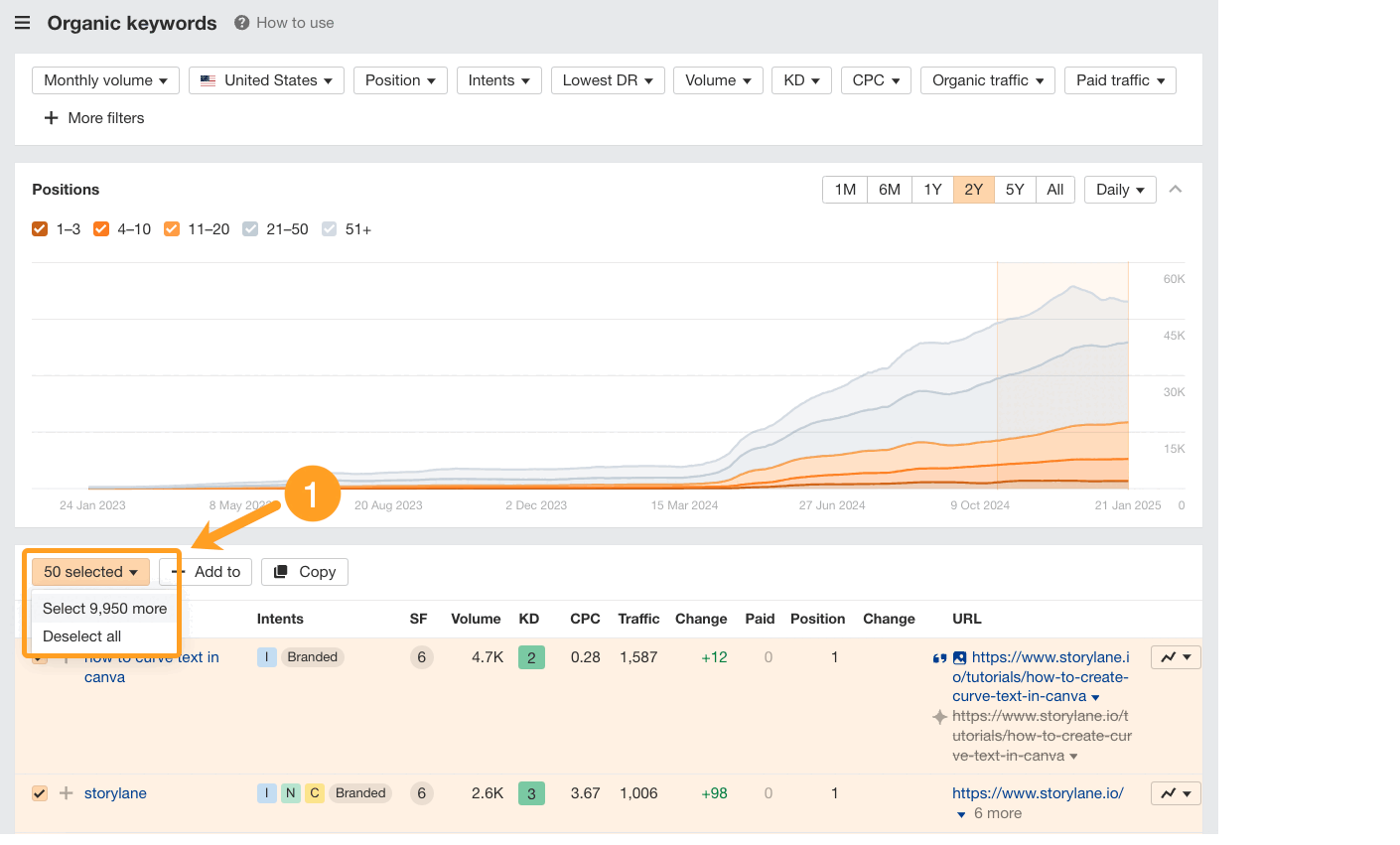
Metrics to measure
Each month, report on key metrics such as Share of Voice uplift, traffic and position improvements, and traffic share percentage.
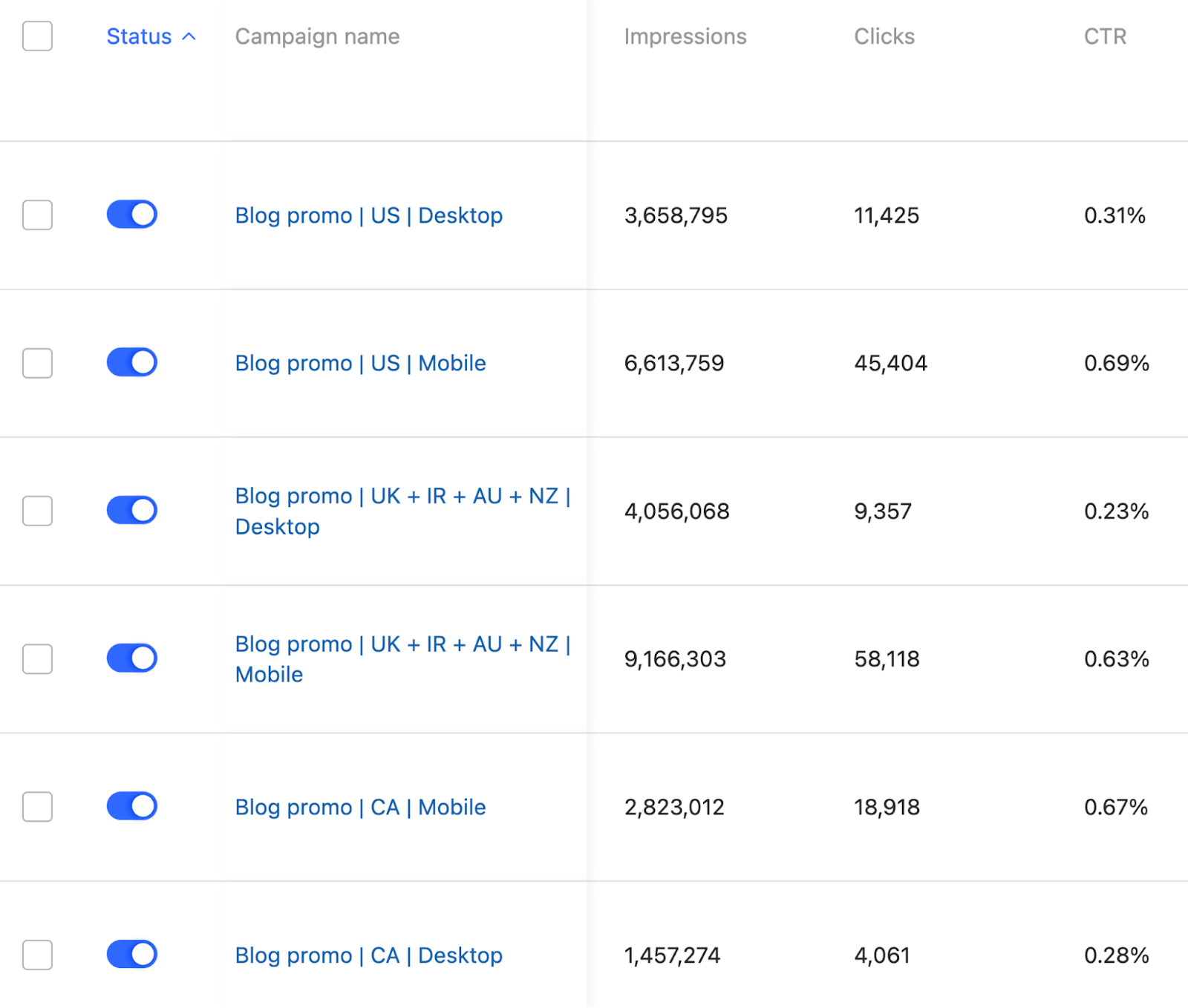
Here are a couple more ways you can measure the success of your ads using Ahrefs.
Measure the success of PPC brand awareness campaigns
Head to Site Explorer and enter your domain¹, then find the Paid Pages report². Other reports in Ahrefs let you dive into the minutiae of your search ads, but this is one of the best places to study overarching ad awareness.
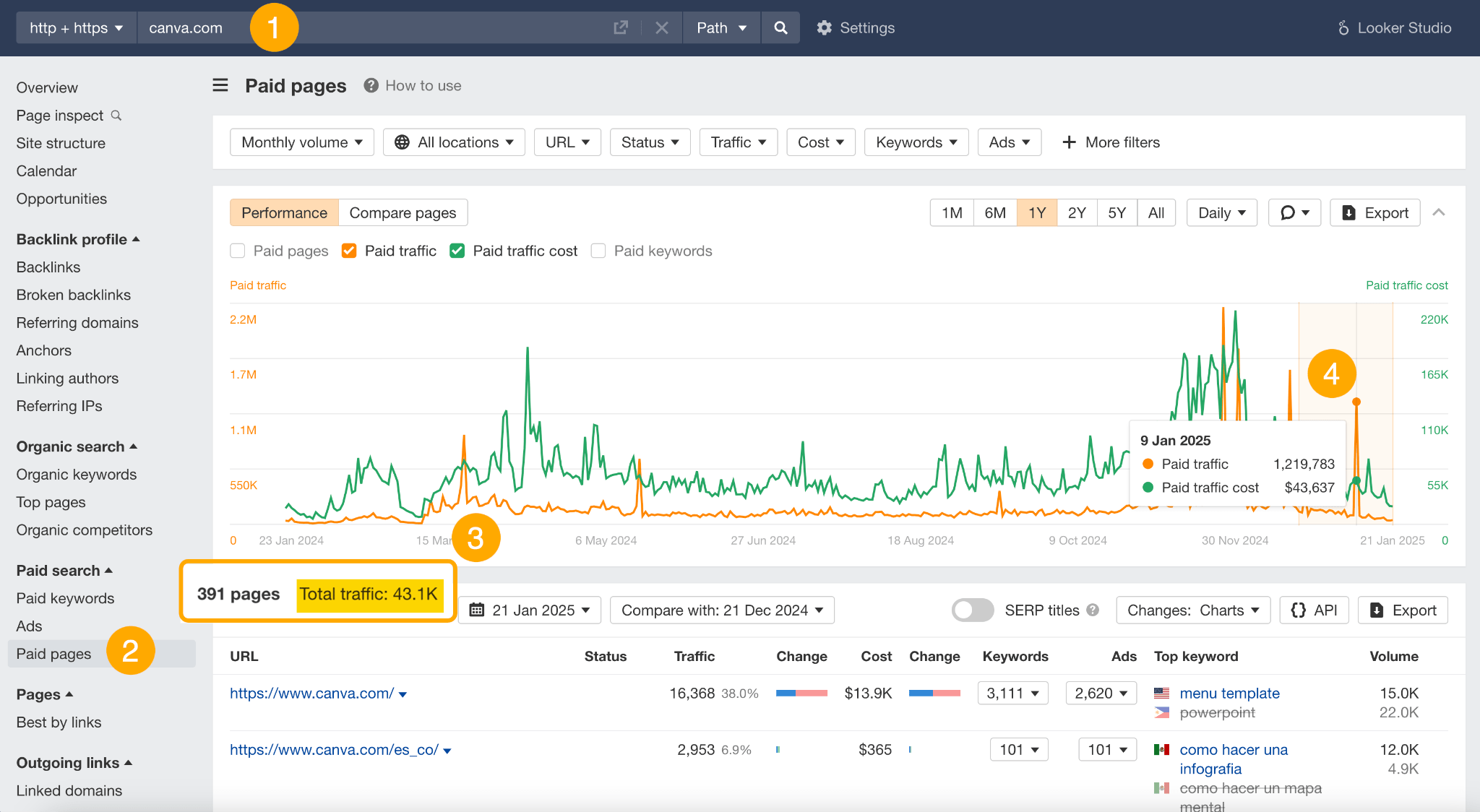
Once you’re there, make a note of your Total Traffic³ at the top of the keyword table, and then study your paid traffic growth over time⁴—especially in relation to ad cost. When your paid traffic exceeds paid traffic cost, it’s a good sign that your brand awareness ads are doing the trick!
In this report, you can also filter by keywords in URLs, titles, and descriptions to better report on the campaign-specific brand awareness.
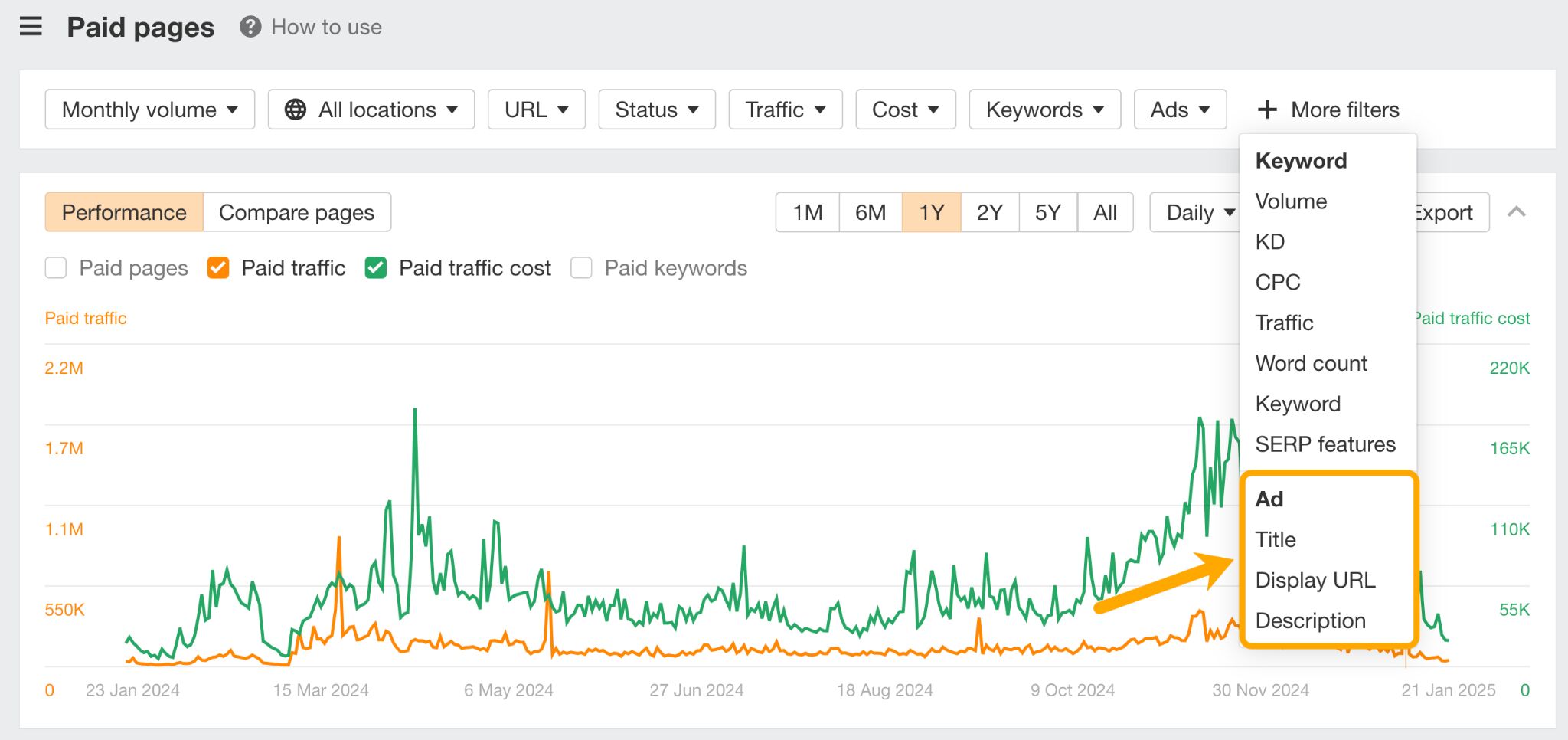
Metrics to measure
Report monthly on metrics such as total paid traffic and campaign-specific paid traffic.
Track total uplift in PPC traffic
For a birdseye view over your brand ads, pull up the Overview report in Site Explorer. It’s great for checking your:
- Total ad traffic vs. organic traffic
- Gross ad traffic growth and decline
- Location based and regional awareness
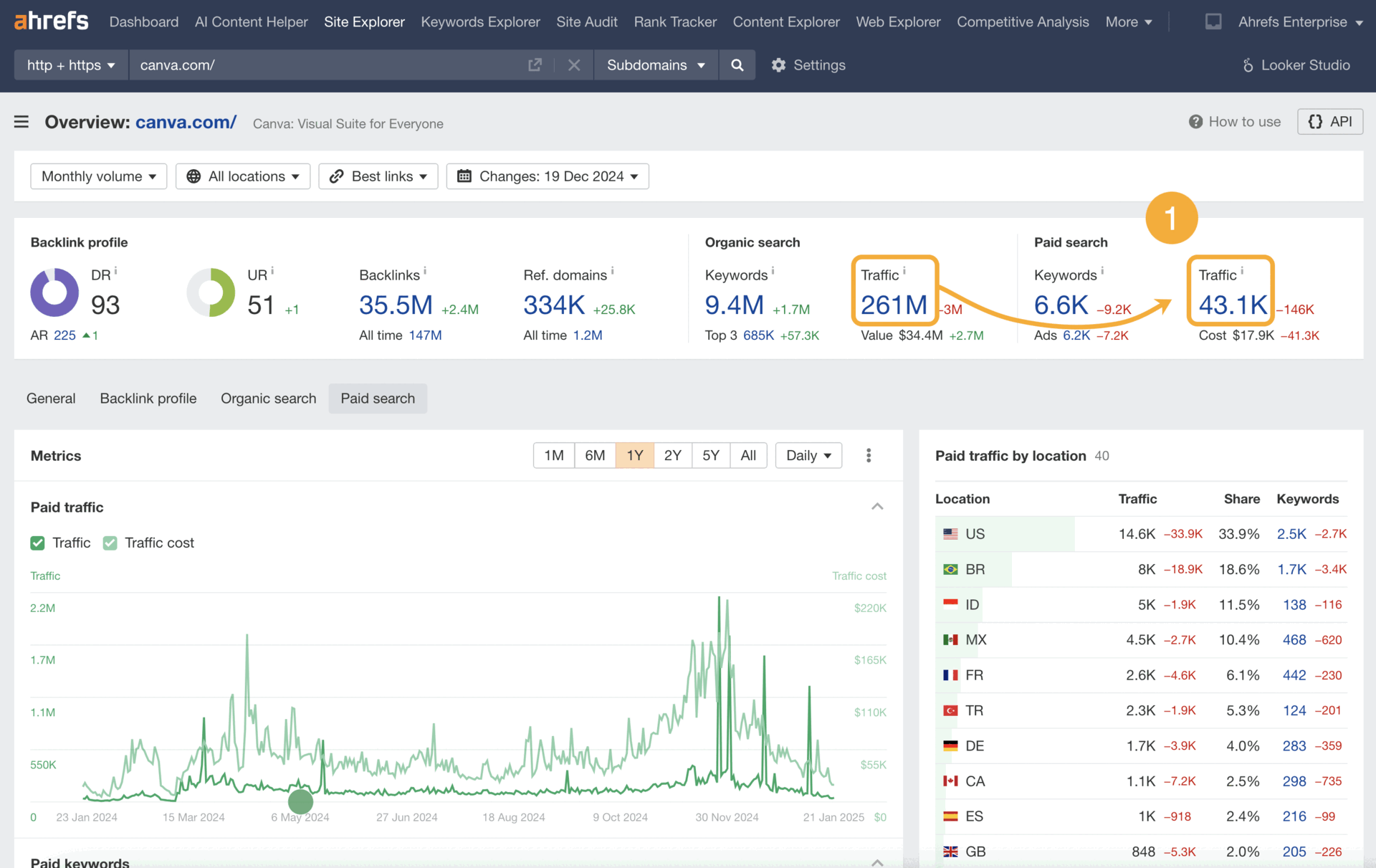
Metrics to measure
Each month, record metrics such as paid traffic as a percentage of organic traffic, paid traffic growth/decline, and location-based paid traffic growth/decline.
Metrics to measure
Report monthly on your total brand anchors, new brand anchors, and brand anchors as a percent of the total.
Measure brand awareness in terms of referral traffic
If you want to see which one of your brand awareness tactics have pushed users through the funnel, then it’s a good idea to report on referral traffic—this will show you the number of users that actually made it back to your site.
You can track this in GA4, via the report I mentioned earlier on:
Acquisition → Traffic Acquisition: Session default channel group report.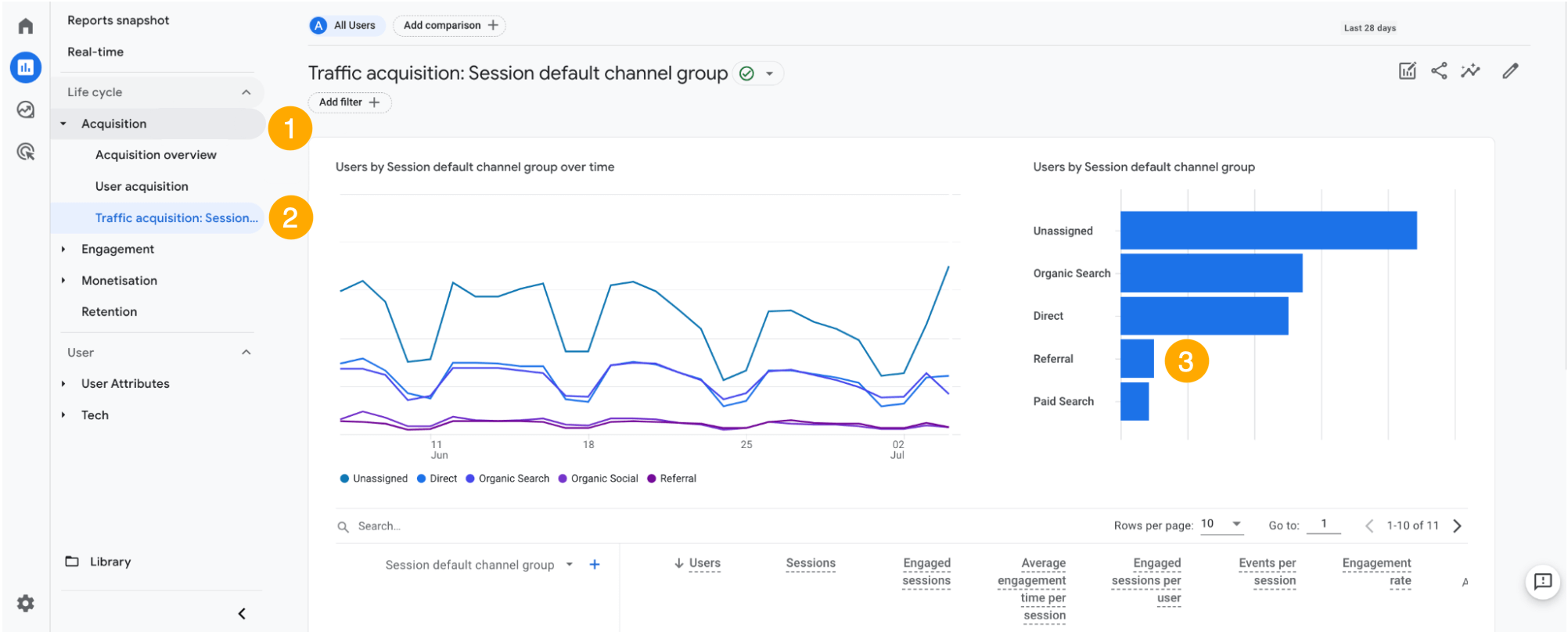
Or you can dig into your traffic in Ahrefs Web Analytics.
Just add a “Channel” filter for referral traffic.
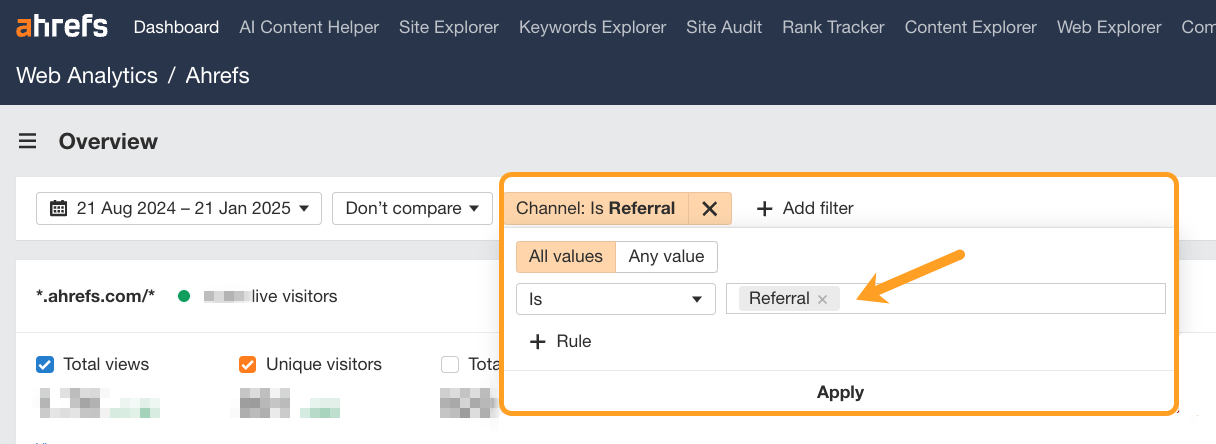
Metrics to measure
Each month, record your total referral traffic, campaign-specific referral traffic, plus any growth.
…or doing a lo-fi brand spoof like smartphone manufacturer Nothing…
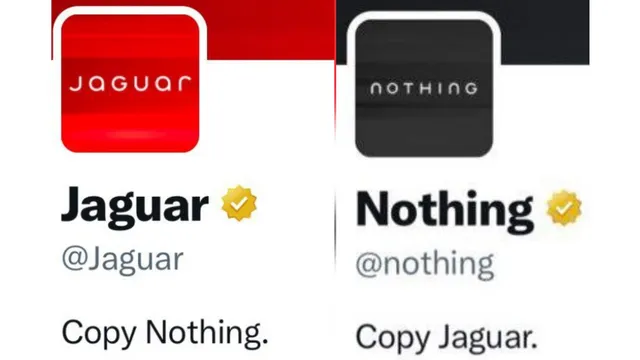
…the very least you can hope for is a spike in social media engagement following your brand awareness campaigns.
Here are some metrics to look at when you’re assessing your brand awareness on social.
Social media mentions and sentiment growth (earned)
You can use social listening tools to scour for earned mentions of your brand, and set up queries for your:
- Campaigns
- Products/services
- People
- Any other brand associations
Once you’ve tapped into brand-relevant conversations, you can make note of your total reach, and measure how much awareness your brand has sparked in the market.
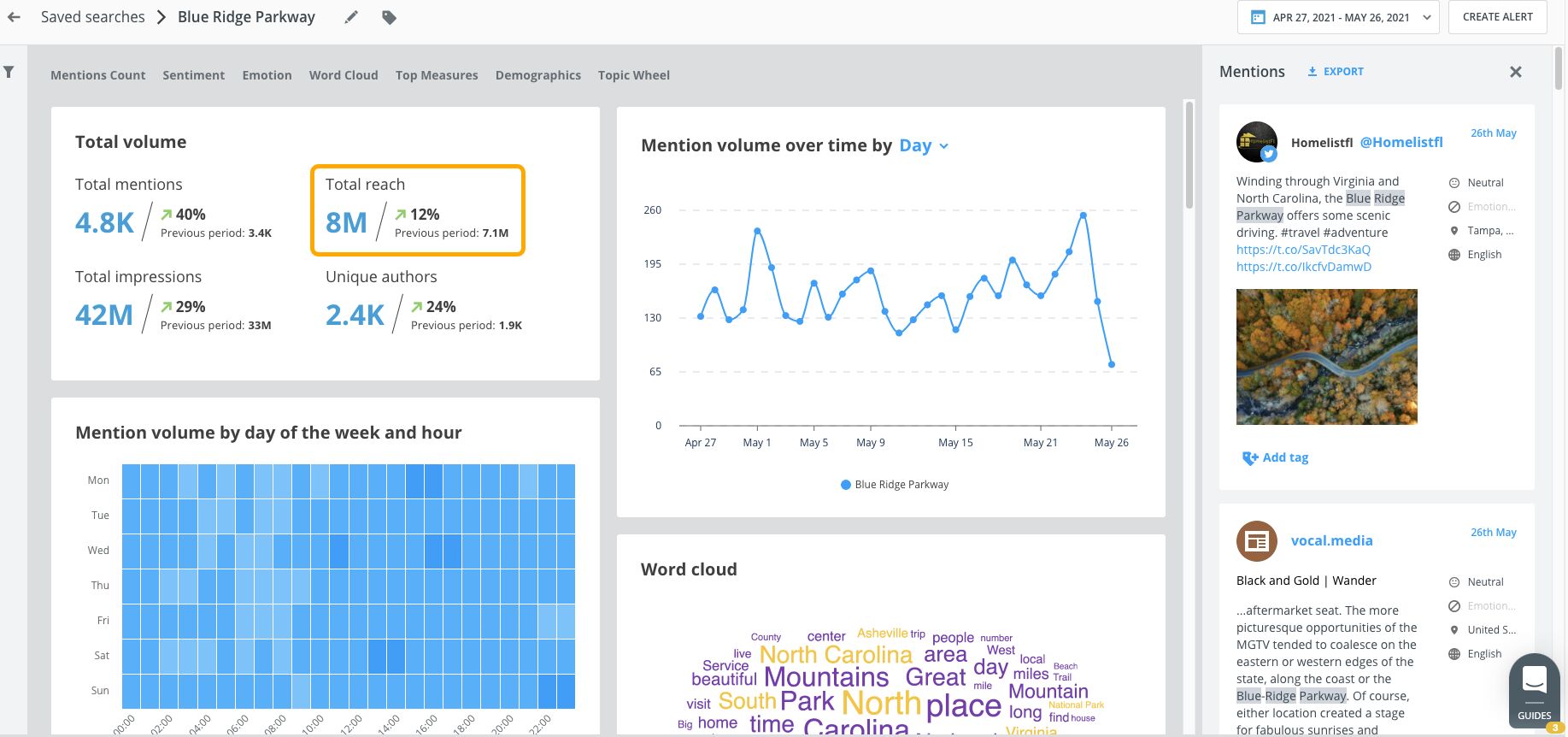
Brandwatch’s social media management tool, highlighting the total reach of social content
For years, social tools have been able to analyze the language of your brand mentions, and decree whether they’re positive, negative, or neutral in sentiment. I imagine this kind of analysis is only going to get better with advancements in AI and LLMs.
If you want to quantify the qualitative (read: “fluffier”) parts of your brand, then sentiment scores are another great metric to include in your reporting.
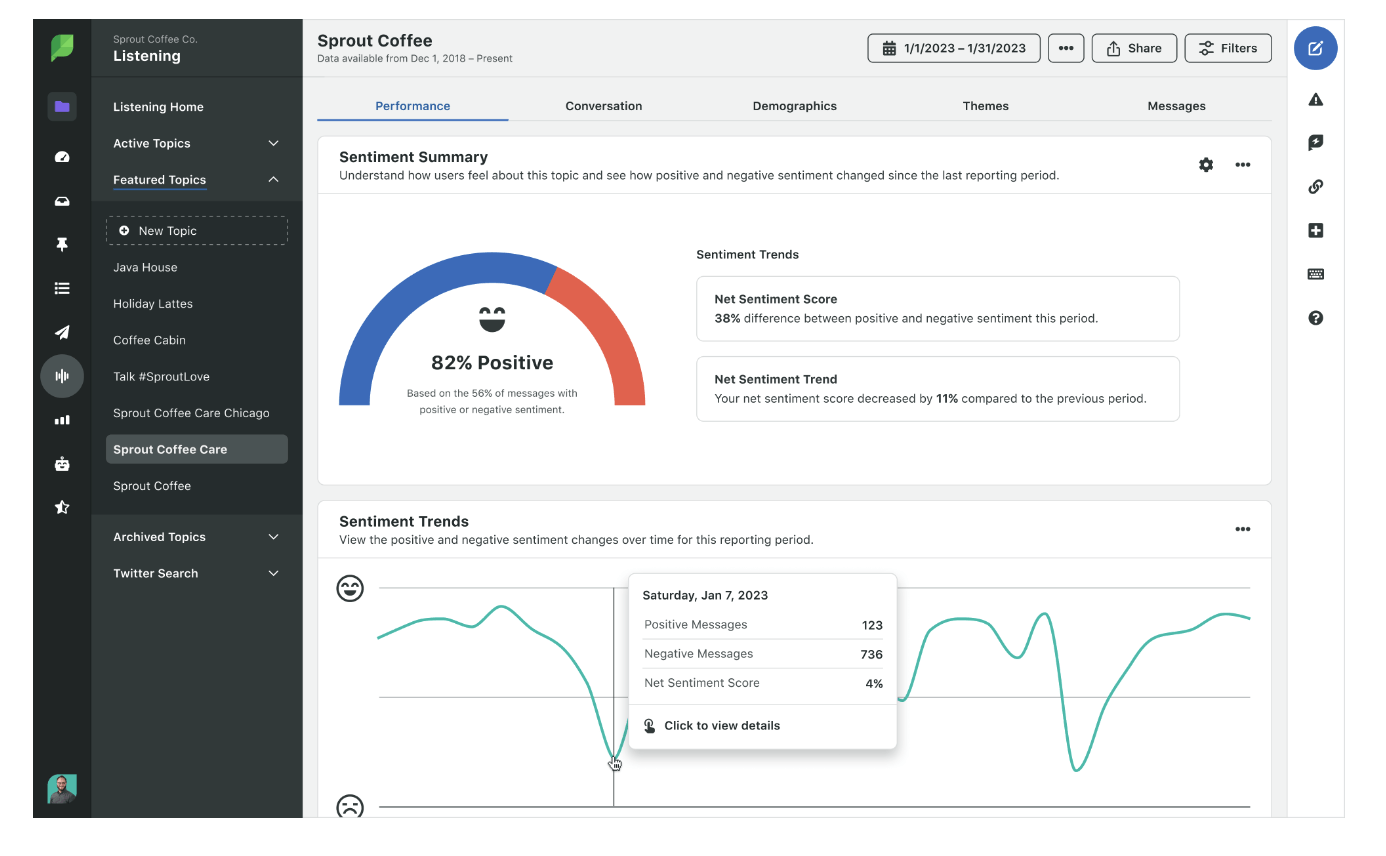
Sentiment trends and scores in Sprout Social
Sentiment scores in SproutSocial
Metrics to measure
Each month, report on: your most important engagement metrics (e.g. subscribers), your total reach for brand-relevant keywords, and your brand sentiment scores.
But at the same time, AI overviews are sending more awareness and traffic to certain (cited) brands.
It’s a similar story with AI chatbots: They’re encroaching on organic traffic, but what they take with one hand, they give with another—mentioning, recommending, and linking to brands in customer conversations.
Whatever you make of them, these new awareness channels are still largely untapped, and offer huge potential for brands that get in early.
Here’s how to increase brand awareness in AI.
Track your ownership of AI overview keywords
Keeping a handle on your awareness today means tracking your brand ownership of AI overviews. There’s a straightforward way to do this in Ahrefs:
- Head to the Organic Keywords report
- Set a SERP feature filter
- Click “Where target ranks”
- Select AI overview
- Set your monthly date range
This will show you which AI overview keywords you have picked up since last month, along with any organic traffic uplift.
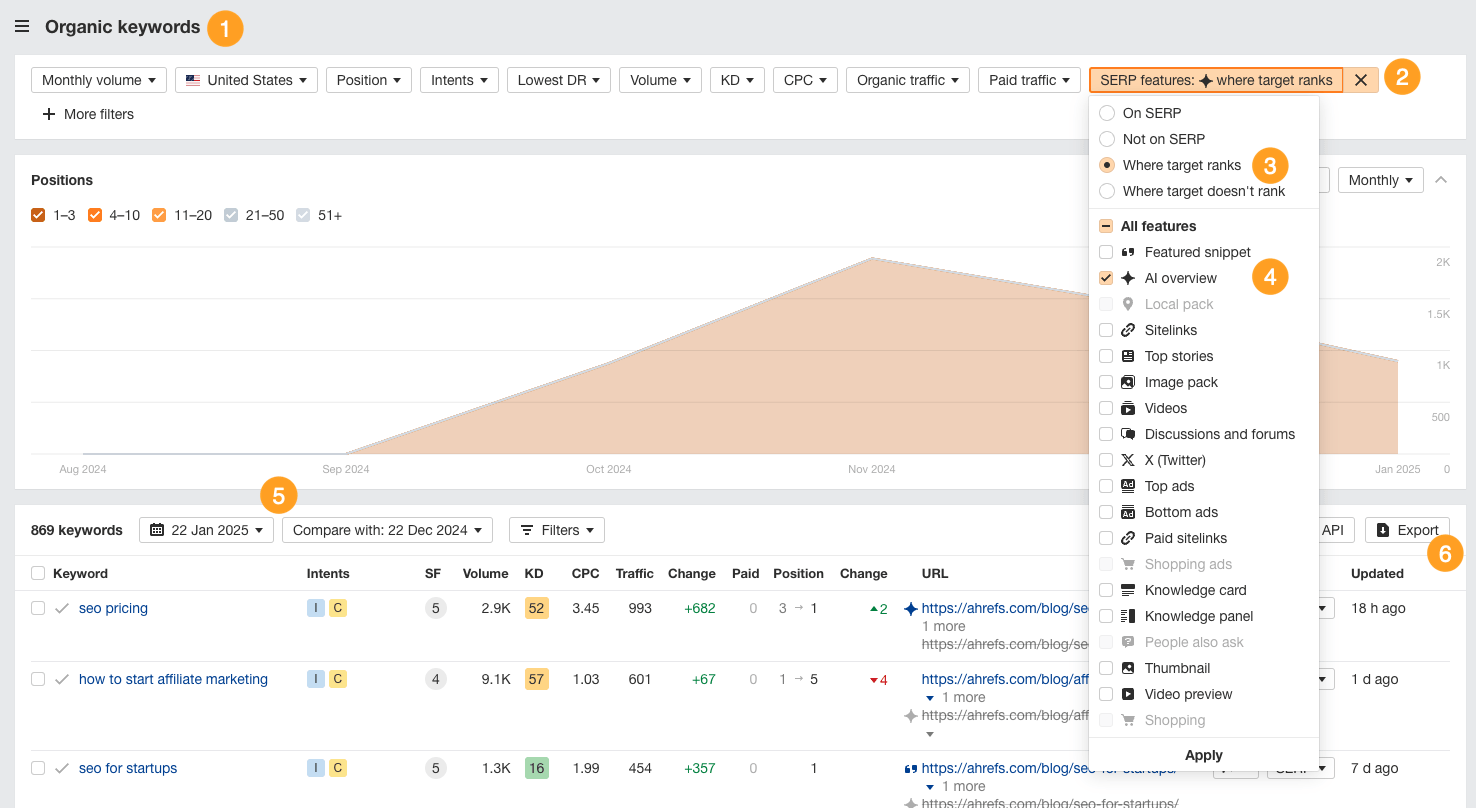
Make a note of the total keywords each month (shown in the position history chart) to measure your AIO awareness over time.
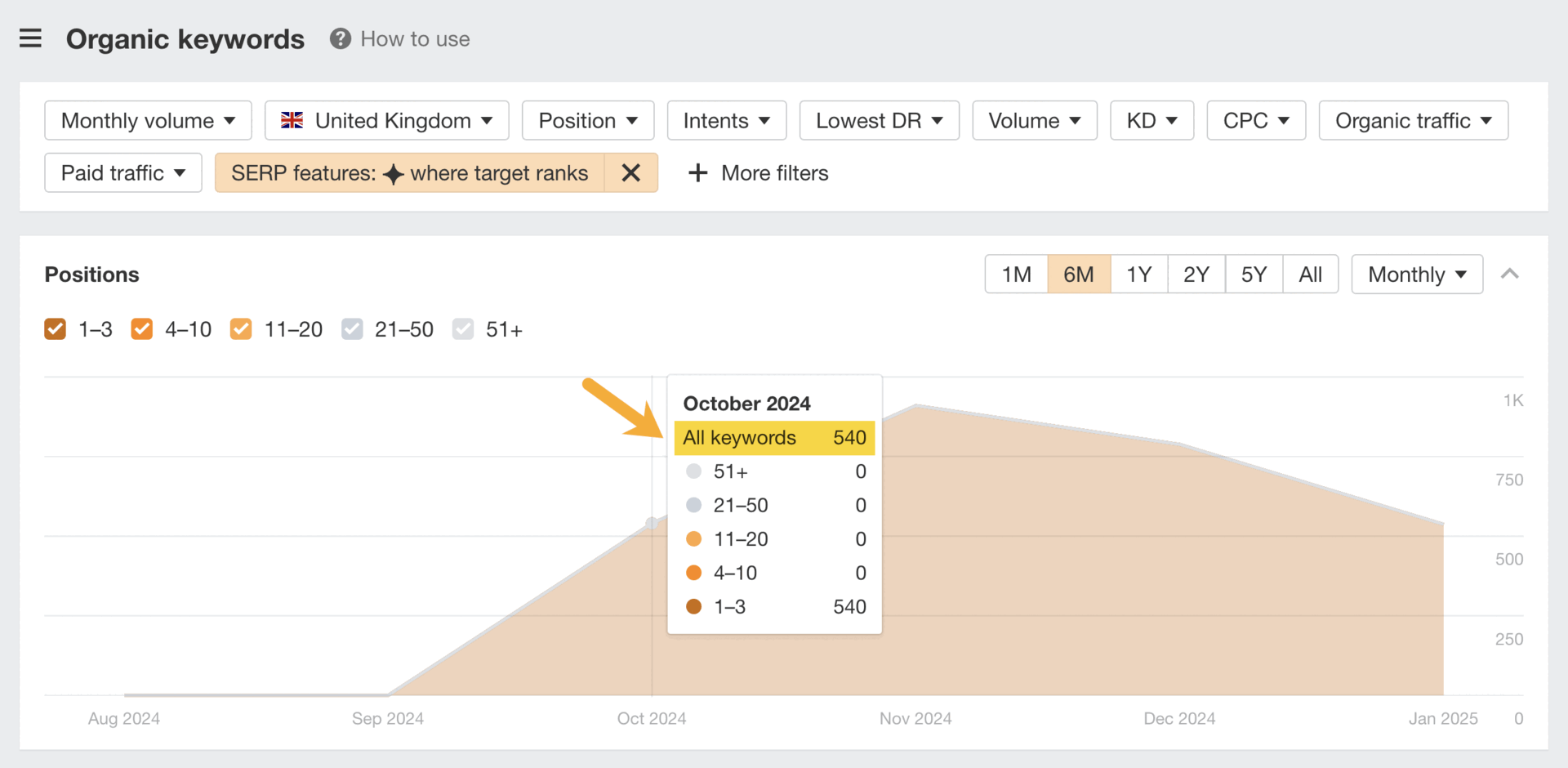
Metrics to measure
Report monthly on your total AI overview keywords, and your average organic traffic uplift.
Track your AI /LLM referral traffic
To find out how often your brand is cropping up in AI conversations, you can configure a report in Ahrefs Web Analytics.
Just select the “Channel” filter and choose ”LLM” to assess your traffic from popular AI chatbots.
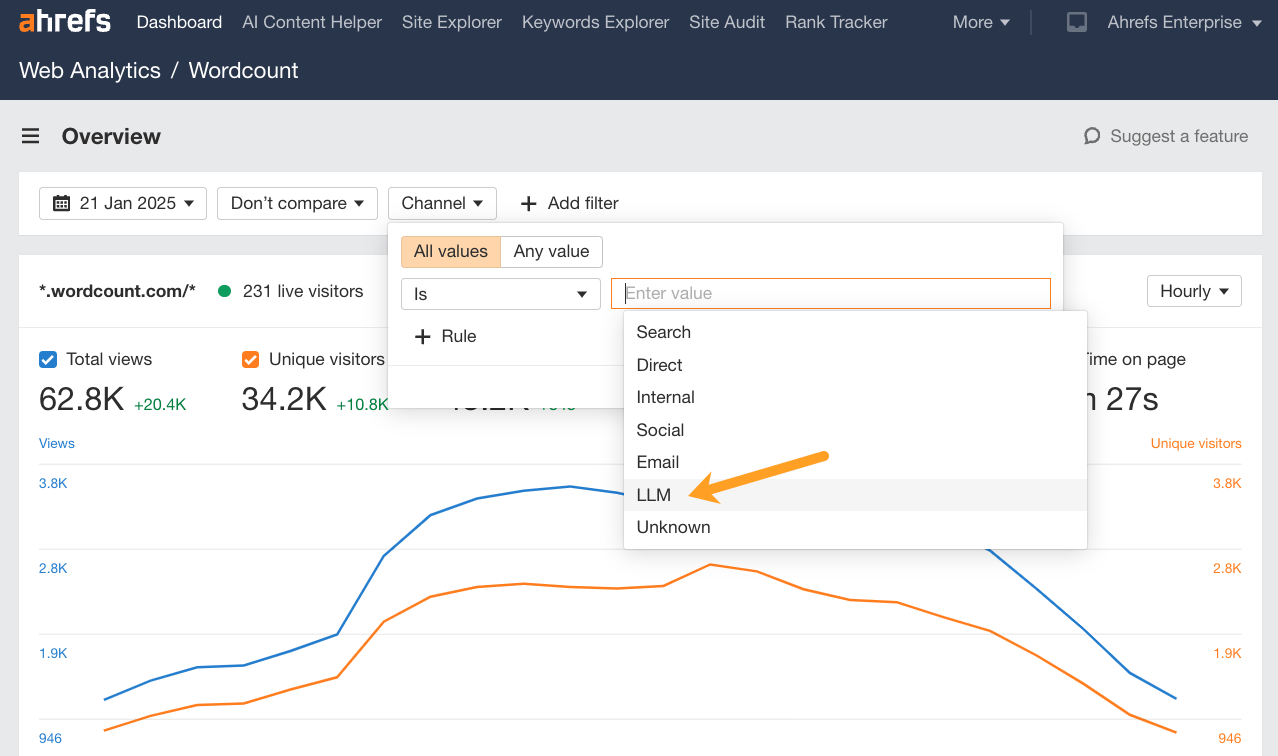
Pay close attention to the types of pages and content getting cited. This will give you a better idea of the content formats to double down on.

For instance, we’re getting most of our AI brand visibility from stats, tools, courses, and trend-based blogs, so we should probably create more of that content to continue turning up in relevant AI conversations.
Metrics to measure
Report monthly on your referral views and visits from AI, making a note of growth and content-type success.
Measure your brand ownership of relevant topics
Large language models generate content by calculating the statistical proximity between topics and entities.
The more commonly topics appear together in training data, the more statistically significant their connection, and the more likely an LLM is to mention those topics together in a response.
Meaning, if you make a conscious effort to align your brand with relevant topics, it’s more likely to crop up alongside those topics in AI.
You can track your brand alignment efforts in Ahrefs by measuring co-mentions of your brand alongside key topics.
Just head to the Content Explorer and:
- Do a search for your brand name
- Check your total brand mentions
- Do a boolean search for your brand name AND “topic”
- Check the number of topic mentions

In this example, 3.2% of Patagonia’s brand mentions also mention the keyword “sustainability”.
Monitoring these figures can give you a solid sense of your overall topical authority.
Metrics to measure
Record your monthly topic mentions, topic mentions as a percent of total mentions, and number of topic mentions vs. competitors.
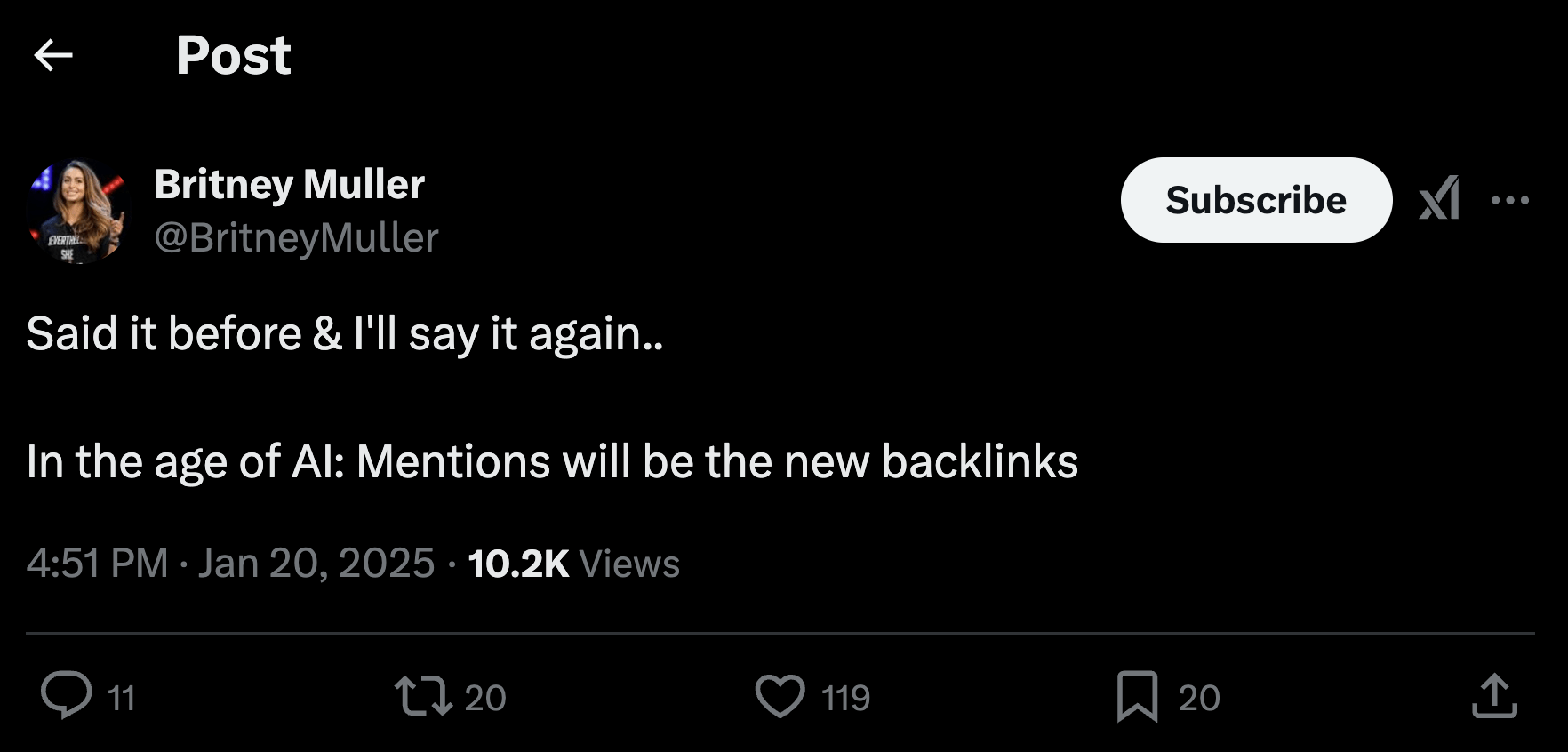

According to research from Seer Interactive, links actually display the weakest correlation of all common SEO factors when it comes to LLM visibility.
Disregard brand mentions at your peril!
Track your brand mentions
In Content Explorer¹ do an “Everywhere”² search for your brand name³, and note down the number of pages⁴ that return. Keep hold of that figure, until you update it the following month—then note the number of new pages⁵.
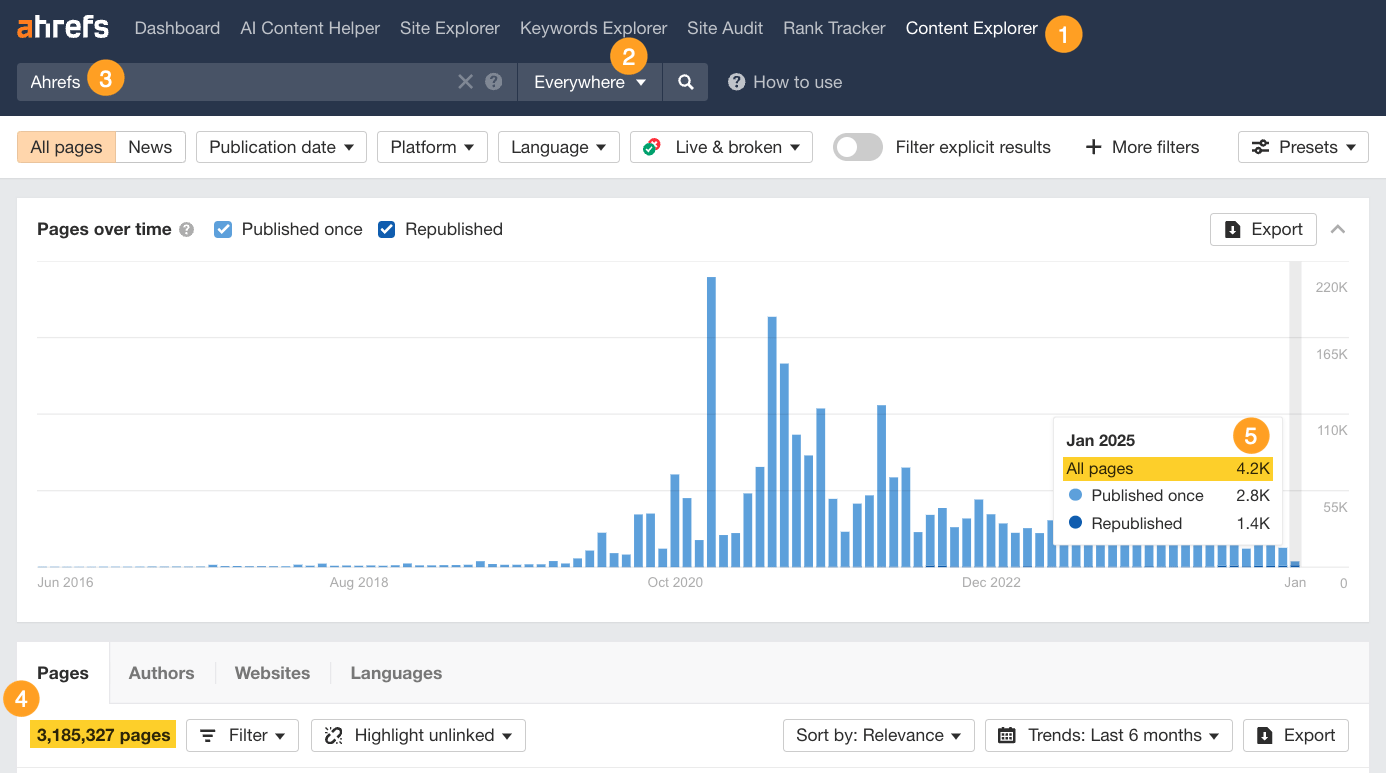
Metrics to measure
Every month, note down the number of pages mentioning your brand, taking into account any growth.
Using Google Tag Manager, for example, you can track when a user comes to your site via a brand campaign link, clicks on a converting CTA, loads a specific URL fragment, or takes any other action that infers/equates to a conversion. Then, you can measure all those events in GA4.
Once you have that data to hand, you can calculate conversion rates—just divide conversions by the number of total visitors.
For example, imagine the UK meal delivery brand Cook running a “CookTok” campaign of recipe challenges on TikTok. If 1,000 users visit the campaign landing page after watching the videos, and 50 sign up for a subscription, the conversion rate would be 5% (50/1,000).
If you can’t make event tracking work, then another alternative is tracking conversions and sales increase during periods of high brand awareness, so you can loosely connect the dots between awareness and revenue.
While it’s true that brand awareness campaigns don’t always neatly track back to conversions, if your conversion rate is nonexistent over an extended period of time, you might need to start troubleshooting—it could signal that there’s something wrong with your brand messaging, UX, or tracking.
Final thoughts
Measuring brand awareness in 2025 isn’t just possible—it’s a prerequisite.
These are 11 concrete ways I think you can successfully prove your brand’s impact.
The next step would be to combine these metrics to build a complete picture of your brand awareness.
Once you’ve brought everything together, you’ll have a much better understanding of how to increase your brand awareness.
I’m looking to create a Looker Studio dashboard of Ahrefs’ brand data for this very reason. If you have any smart techniques I’ve missed off, ping me on LinkedIn. I’m all ears!
Similar Posts
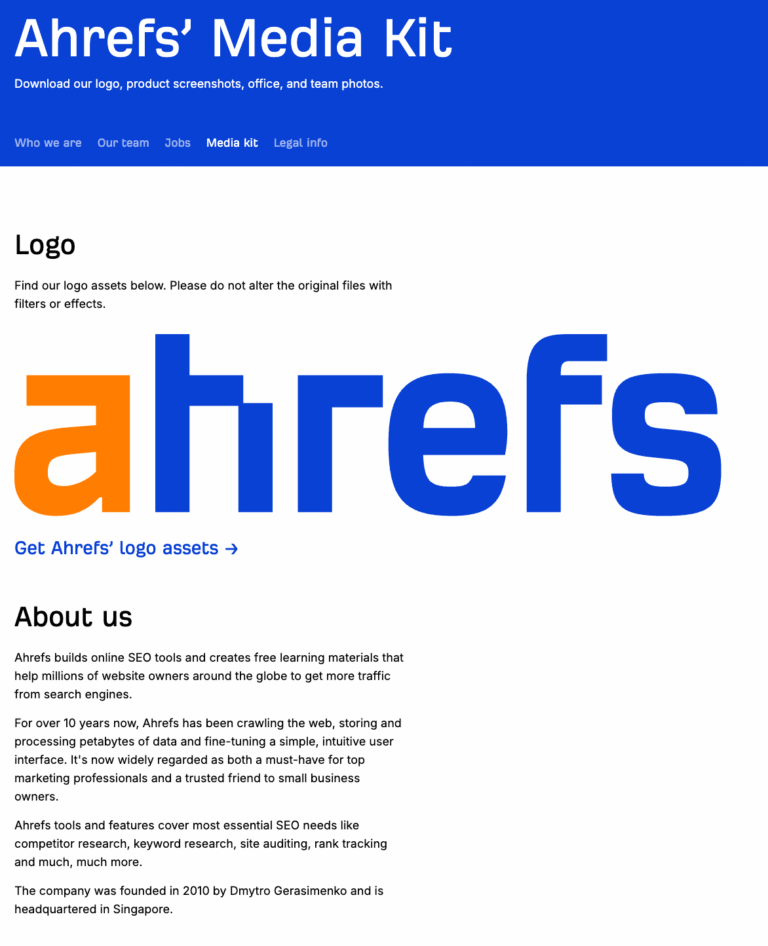
My Exact 7-Step Framework for Brand SEO (With Templates)
Branding wasn’t something SEOs traditionally thought much about. The real wins were in non-branded keywords, where the traffic and conversions lived. However, that changed when Google and OpenAI turned most of these queries into zero-click searches. For the remaining queries, search platforms directly reward authoritative and popular brands, so branding can no longer be ignored…
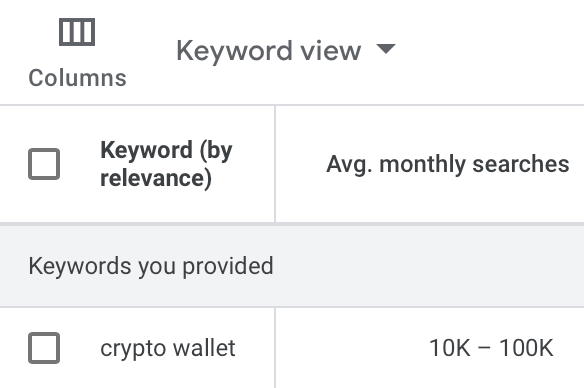
PPC Keyword Research for Google Ads: A First-Timer’s Guide
PPC keyword research is the process of finding the exact words or phrases people type into Google when they’re looking for something related to your product or service. It helps you target the right audience, avoid wasting money on irrelevant clicks, and attract people who are actually ready to buy. When I asked experts for their…
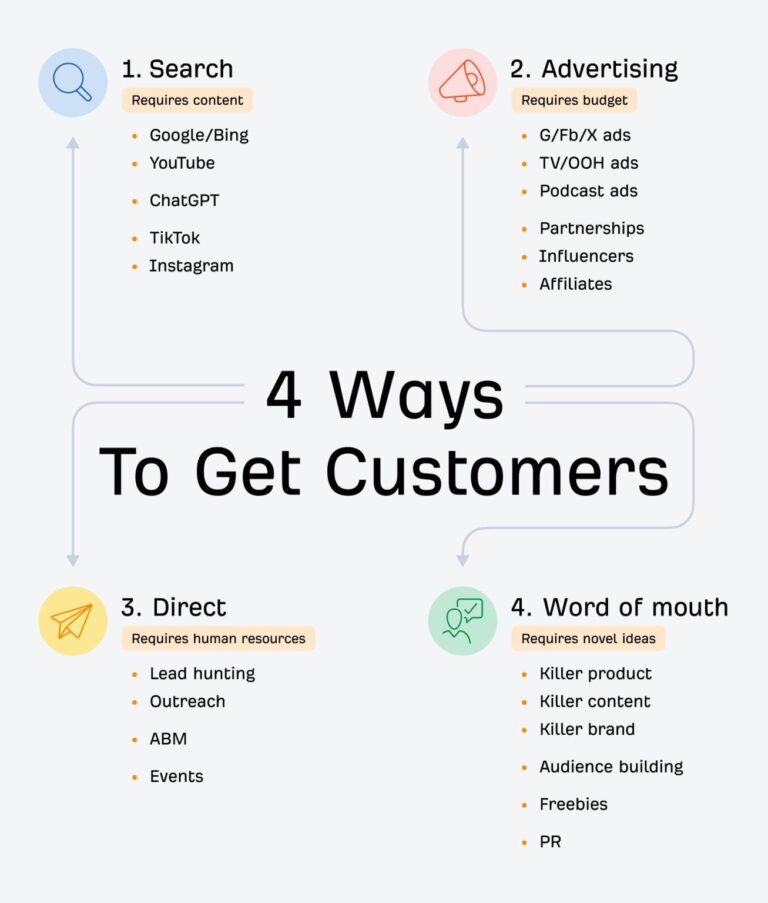
How to Get Customers (There Are Only 4 Ways)
Getting customers is the lifeblood of any business. But search for “how to get customers,” and you’ll find yourself flooded with advice, tips, and tactics. It’s hard to know which one to choose, considering that you have limited resources. Fortunately, most strategies on how to get customers boil down to these four fundamental methods: Find…
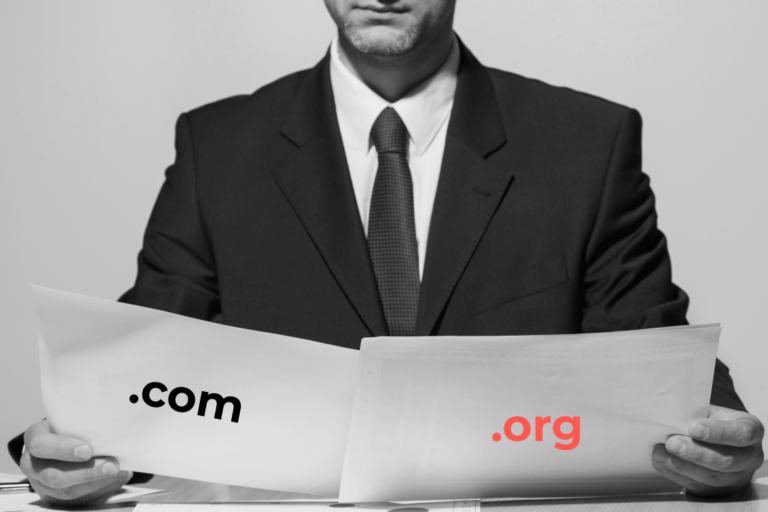
.org vs .com: What’s the Difference & How to Choose Which Domain Extension Is For You
.com and .org are both well-known examples of domain extensions. But what is .com exactly, and what is .org? And does it matter which one you use? (Spoiler alert: yes.) When you set up a website for a business or a non-profit organisation, you might think the most important part of the address is the…
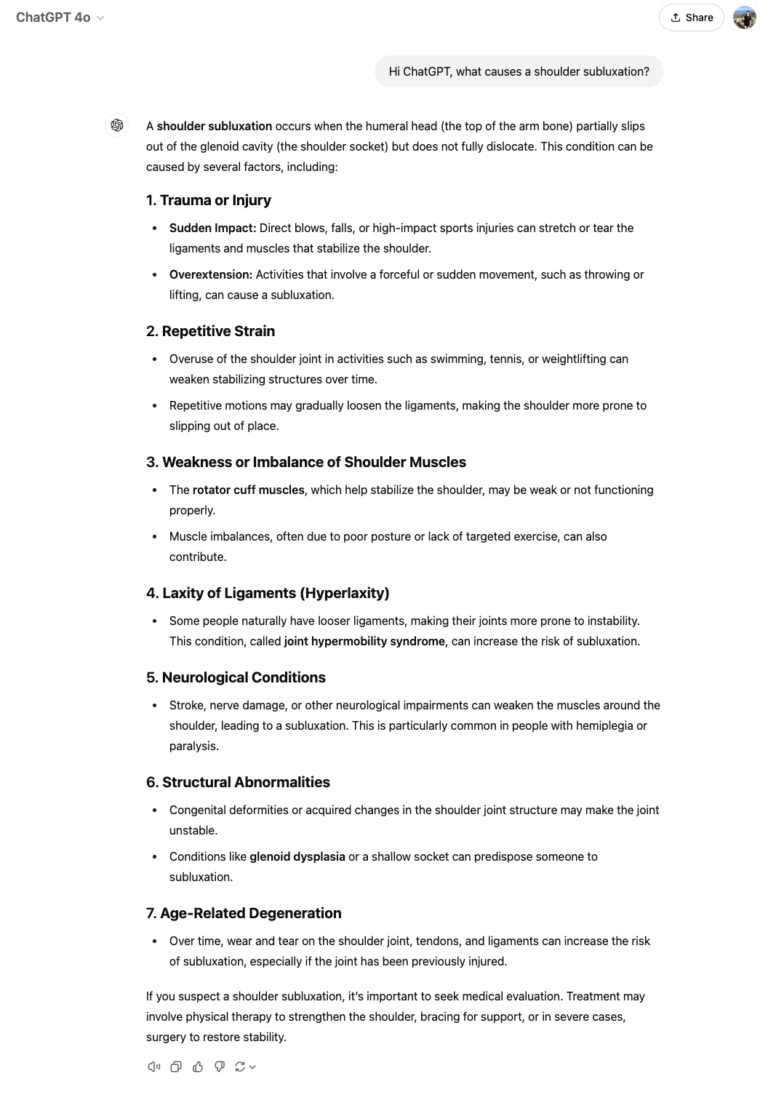
Our 9 Best ChatGPT Alternatives for 2025 (So Far)
During my flat-sharing days, I had a housemate that would follow me room to room, chattering away for hours—even when I hid in the bathroom for some peace, he’d monologue at me through the door. ChatGPT reminds me of him—nice enough, spits out some interesting facts, but boy can that AI go on. And, unfortunately,…
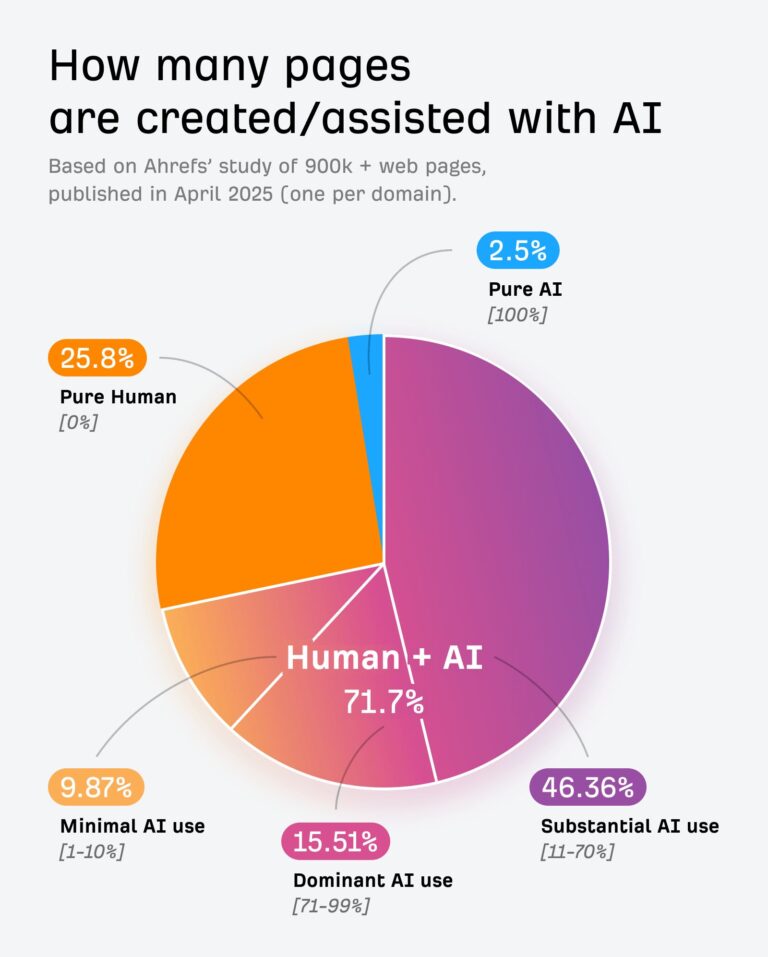
How to Detect AI-Generated Content
In April 2025, we analyzed 900,000 newly created web pages and discovered that 74.2% contained AI-generated content. With the rapid growth of generative AI, businesses, educators, and publishers are asking a critical question: how can we tell what’s written by humans and what’s produced by machines? The answer: it’s possible, but not foolproof. Here’s how…

